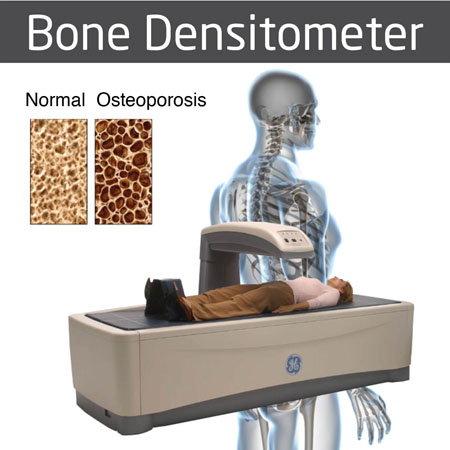Radiotherapy

(a) Radioactive iodine is used both to obtain images of the thyroid and to treat thyroid cancer. Injected iodine-123 or iodine-131 is selectively taken up by the thyroid gland, where it is incorporated into the thyroid hormone: thyroxine. Because iodine-131 emits low-energy β particles that are absorbed by the surrounding tissue, it can be used to destroy malignant tissue in the thyroid. In contrast, iodine-123 emits higher-energy γ rays that penetrate tissues readily, enabling it to image the thyroid gland, as shown here. (b) Some technetium compounds are selectively absorbed by cancerous cells within bones. The yellow spots show that a primary cancer has metastasized (spread) to the patient’s spine (lower center) and ribs (right center).
Table 20.5 Radioisotopes Used in Medical Imaging and Treatment
Because γ rays produced by isotopes such as 131I and 99mTc are emitted randomly in all directions, it is impossible to achieve high levels of resolution in images that use such isotopes. However, remarkably detailed three-dimensional images can be obtained using an imaging technique called positron emission tomography (PET). The technique uses radioisotopes that decay by positron emission, and the resulting positron is annihilated when it collides with an electron in the surrounding matter. (For more information on positron emission, see Section 20.2 "Nuclear Reactions".) In the annihilation process, both particles are converted to energy in the form of two γ rays that are emitted simultaneously and at 180° to each other:
With PET, biological molecules that have been “tagged” with a positron-emitting isotope such as 18F or 11C can be used to probe the functions of organs such as the brain.
Fruits such as strawberries can be irradiated by high-energy γ rays to kill bacteria and prolong their storage life. The nonirradiated strawberries on the left are completely spoiled after 15 days in storage, but the irradiated strawberries on the right show no visible signs of spoilage under the same conditions.
Radiation Imaging Detectors for Plant Photosynthesis Research
Additionally, because plants typically have very thin leaves, often little medium is present in the leaves for the emitted positrons to undergo an annihilation event needed for PET imaging. In this case, most of the positrons do not annihilate inside the leaf, resulting in limited sensitivity for PET imaging. To address this limitation, Jefferson Lab has also developed PhytoBeta, a compact high resolution beta-positive particle imager for 11CO2 leaf imaging. The detector is equipped with a flexible arm to allow its placement and orientation on or under the leaf to be studied while maintaining the lea''s original orientation.
Too much radiation raises the risk of cancer. That risk is growing because people in everyday situations are getting imaging tests far too often. Like the New Hampshire teen who was about to get a CT scan to check for kidney stones until a radiologist, Dr. Steven Birnbaum, discovered he'd already had 14 of these powerful X-rays for previous episodes. Adding up the total dose, "I was horrified" at the cancer risk it posed, Birnbaum said.
After his own daughter, Molly, was given too many scans following a car accident, Birnbaum took action: He asked the two hospitals where he works to watch for any patients who had had 10 or more CT scans, or patients under 40 who had had five — clearly dangerous amounts. They found 50 people over a three-year period, including a young woman with 31 abdominal scans.
Radionuclides and radiotracers[edit]
Radionuclides used in PET scanning are typically isotopes with short half-lives [2] such as carbon-11 (~20 min), nitrogen-13 (~10 min), oxygen-15 (~2 min), fluorine-18 (~110 min), gallium-68 (~67 min), zirconium-89 (~78.41 hours), or rubidium-82(~1.27 min). These radionuclides are incorporated either into compounds normally used by the body such as glucose (or glucose analogues), water, or ammonia, or into molecules that bind to receptors or other sites of drug action.
Nuclear medicine therapies include:
- Radioactive iodine (I-131) therapy used to treat some causes of hyperthyroidism (overactive thyroid gland, for example, Graves' disease) and thyroid cancer
- Radioactive antibodies used to treat certain forms of lymphoma (cancer of the lymphatic system)
- Radioactive phosphorus (P-32) used to treat certain blood disorders
- Radioactive materials used to treat painful tumor metastases to the bones
- I-131 MIBG (radioactive iodine labeled with metaiodobenzylguanidine) used to treat adrenal gland tumors in adults and adrenal gland/nerve tissue tumors in children

More pictures
https://www.dreamstime.com/photos-images/spine-pathology-nuclear-medicine.html
Computing Tomography
MRI, MRA
You will receive a contrast injection. MRI contrast is an organically bound gadolinium material that is used to make some abnormalities easier to see. Gadolinium in the medical setting is extremely safe and typically has no side effects.
-
You have pacemaker
-
You have metallic plates, pins or other implants
-
You have brain aneurysm clips
-
You have ever been employed as a metal worker
-
You have ever been wounded during military service

















